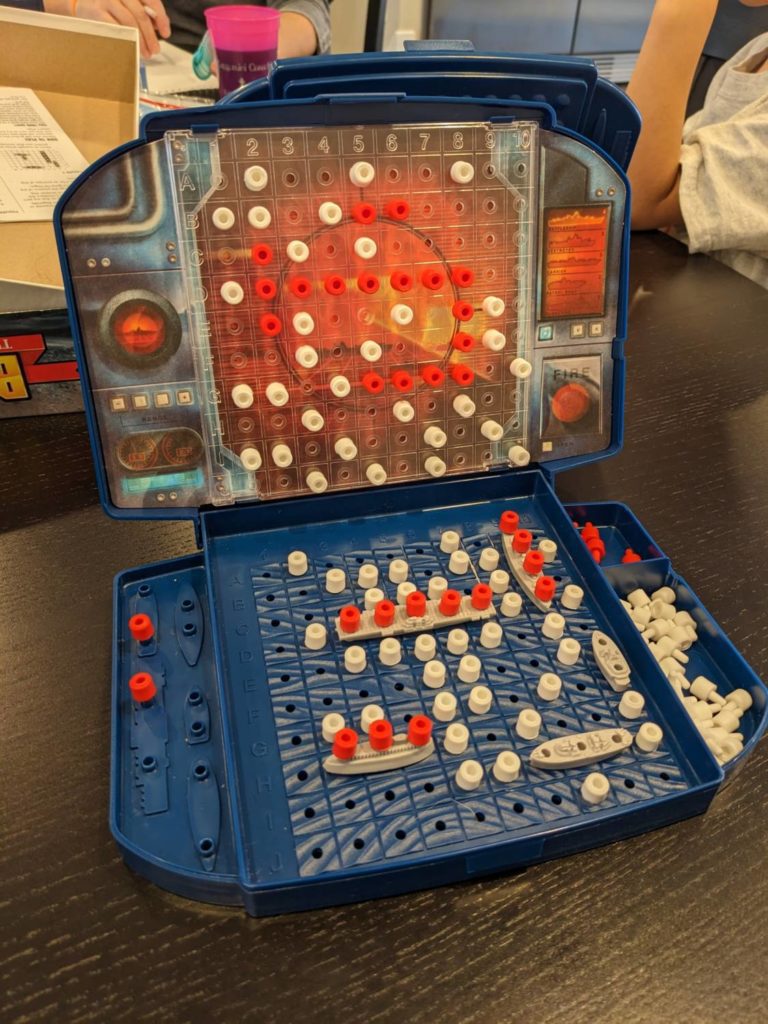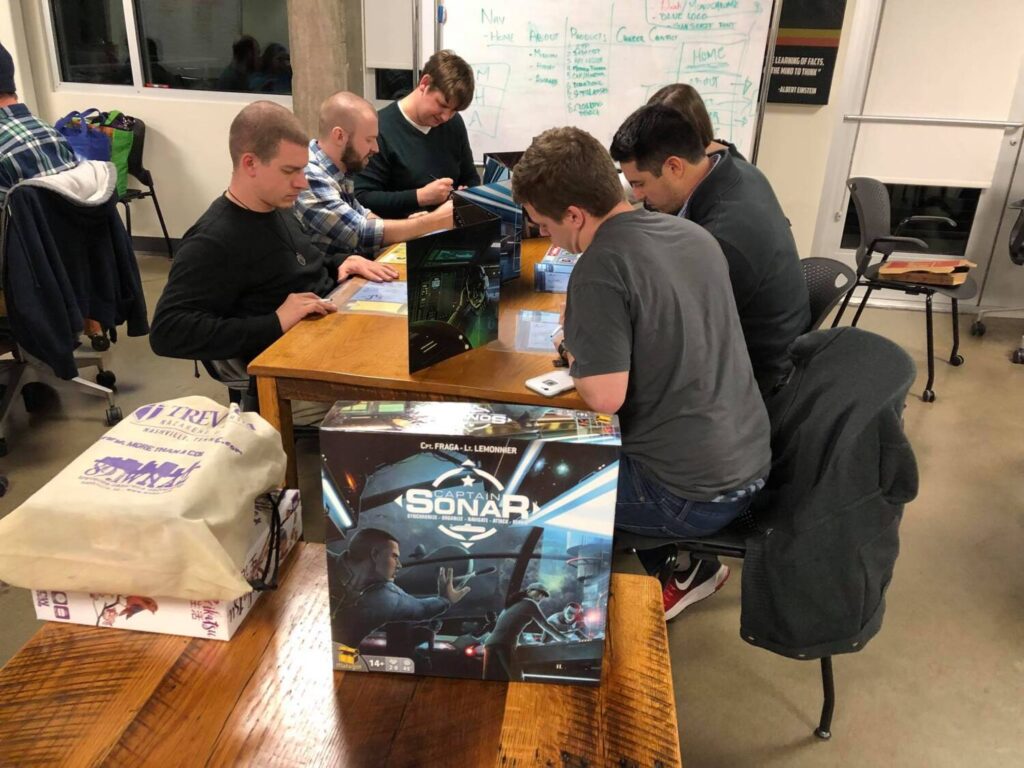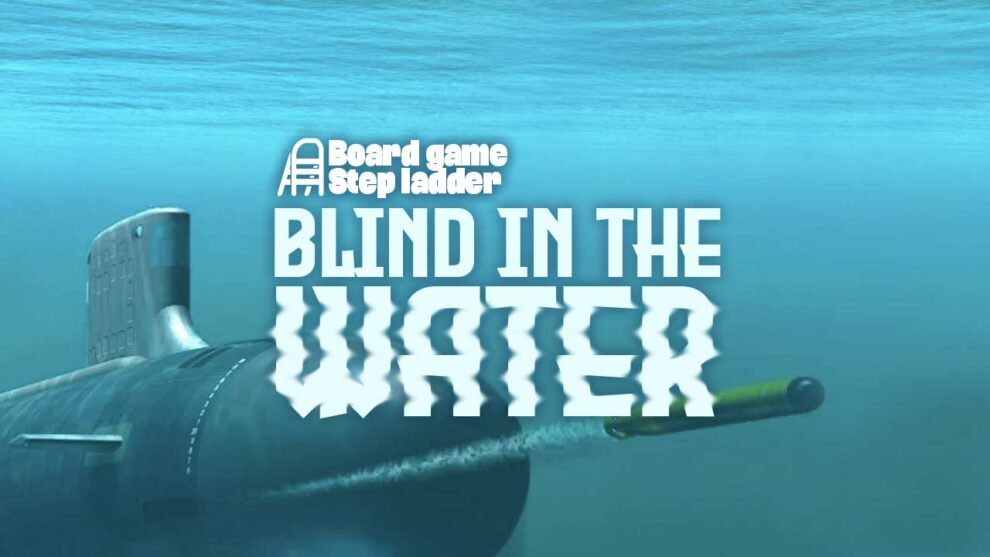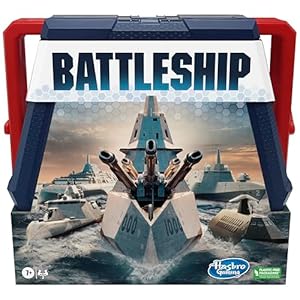Imagine being several hundred feet underwater, trapped in a hollow metal tube, with nothing but your wits and training at your disposal if you hope to survive. One wrong move and the only evidence of your failure will be some bubbles on the surface of the water, there for a few moments before fading into obscurity. Few things sound more terrifying.
The thrill and excitement of the experience of stalking prey through the unknown using only science, technology, and good old-fashioned intuition is not an easy thing to capture in board game form. Many games have tried it, some succeed better than others. Let’s take a look at three such games in today’s Step Ladder: “Blind in the Water”.
Battleship > Steam Torpedo > Captain Sonar
Battleship
Originally designed as a pen and paper game at the end of World War I, Battleship wouldn’t become the board game it is today until 1967. While the game has undergone some aesthetic and component changes over the ensuing decades, it’s still largely the same game now as it was back in the era when humans were first walking on the moon. The approachable theme combined with the simple mechanics have turned Battleship into a mainstay of many household gaming closets worldwide.
Briefly, here’s how it works:
Players sit across from each other with their foldable game board in front of them. One section is folded up at a 90º angle to form a wall to block the players’ view of their opponent’s board. The main board is laid out in letter-number grid coordinates (A1, G4, etc.). Each player also receives a collection of plastic ships, which they slot into the lower portion of their board, along with a set of red and white pegs.
On a player’s turn, they will guess a coordinate where they think a ship might be located on their opponent’s board. If they guess correctly, they have scored a hit. Otherwise, it was a miss. If it was a hit, the player receiving the hit places a peg in their ship in the spot matching the guessed coordinate. The player who made the guess records their finding on the grid on the upper half of their player board using a red peg. If it was a miss, the guessing player records it on the upper half of their player board using a white peg. Then, it becomes the other player’s turn to guess.
This back and forth keeps happening until one of the players has managed to sink their opponents’ entire fleet. If you sink your opponent’s fleet, you win the game.

While not strictly a game about submarine warfare (there is a submarine included, though), Battleship is still an excellent introduction to the notion of fighting blindly. As the game begins, the players are just lobbing missiles about like they’re tossing birdseed to the pigeons at the park. Then the hits start rolling in. Each successive hit helps to triangulate the next one. Each blip added to the pegboard begins to bring into view the overall big picture.
But, that picture isn’t always what you think it is. Do those four red pegs in a row mean you’re one away from sinking your opponent’s battleship or have they strategically placed their ships in such a way as to make it seem like it is so that you’ll waste guesses trying to land the final blow on spaces that don’t contain anything? Do you fall into their trap? Is it even a trap at all? Maybe they just want you to think it’s a trap, but they’re secretly hoping you don’t sink their battleship.
For being such a simple, straightforward game, there’s a lot of room for cleverness, deception, and deep contemplation. No doubt, it’s for these reasons that Battleship has stuck around for as long as it has.
The next game on our list ramps things up considerably. The rules are more complex, the gameplay is more difficult, and the head-to-head duel is more challenging.
Let me introduce you to Steam Torpedo: First Contact. Out with the blindness and in with the submarine!
Steam Torpedo: First Contact
Steam Torpedo: First Contact (co-designed by Ludovic Roudy and Bruno Sautter and published by IELLO) is a two-player, head-to-head submarine duel in which the players duke it out in a tactical, underwater slugfest. In Steam Torpedo, each player controls a submarine, made up of ten different tiles (either randomly chosen or, as has been suggested by players on BoardgameGeek, drafted), as well as a submarine standee, which is used to represent their submarine’s physical proximity to their opponent’s. Each tile is unique in some ways, but there are commonalities that run throughout them.

Some tiles (called compartments) are combat tiles which, if added to a player’s submarine, lend their attack capabilities. Some are armored, lending their defensive capabilities. Others lend their speed. Most can only be used on your turn, but some can be used during your opponent’s. Regardless of the type, every tile bears a number of gear icons in its upper left corner. These tell you how much oxygen remains in the compartment and how much damage that compartment can sustain before being destroyed and cut off from the rest of the vessel.
On each player’s turn, they begin by removing an oxygen token from their vessel (crew members need to breathe!), and turning their inactive crew members face up, before diving into the action phase. In the action phase, the active player will optionally move their standee (and/or their opponent’s) before engaging in combat. All combat abilities are position-based, so this is where the meat of the game is. Repositioning can also be used defensively if one area of your submarine has already been heavily damaged.
However, each of these abilities requires a crew member to be present. Whenever a crew member is used, it moves one compartment closer to your control room. So, planning your crew member’s path through the ship is important because the crew member manning a compartment this turn will be manning its next door neighbor on the following turn.
Unlike Battleship which only has a single win condition, the aim of Steam Torpedo is to eliminate all of your opponent’s crew members OR destroy your opponent’s control room (the most well-defended area of the sub) OR outlast your opponent in the oxygen game. Also, unlike Battleship, where you spend a great portion of the game completely unaware of your opponent’s set up, in Steam Torpedo, there is absolutely nothing hidden. This perfect information makes for a much more compelling and nuanced game.
The challenge comes from the fact that open information works both ways. While you can clearly see where your opponent’s strengths and weaknesses lie, they can see the same about you. Not to mention, you can both see these things about yourselves. Every move you consider making must be filtered through a lens of uncertainty. You never know how they’ll respond, but you know exactly how far they’ll be able to move and you’ll know which compartments of theirs will be functional on their turn. Finding the fine balance between attack, retreat, and standing your ground is never easy, but it is made somewhat easier because of the open information.
The next game on our list is like a heady mixture of the previous two games—the blind fighting of Battleship and the tactical warfare of Steam Torpedo—with an extra twist. Now, you’re not manning your submarine alone. You’ve got crewmates, and they’re sitting right next to you.
Welcome to Captain Sonar.
Captain Sonar
Captain Sonar is an asymmetric, semi-cooperative, real time, team strategy, deduction game. The goal of the game is to be the first team to score four hits on the opposing team, thereby sinking their sub, sending them to Davy Jones’s locker. Ostensibly, Captain Sonar can be played with anywhere from two to eight people, but it’s really best with a full complement.
At eight people, it allows the players to play the game in real time, which is where Captain Sonar really shines. At lower player counts, the game is played in a turn-based mode. This is because, in Captain Sonar, each player on a team will be manning a specific station (a.k.a. role) with its own unique duties. Each of these stations requires input from another station. At the full player count, each player will be able to perform one of the roles. But, at lower player counts, people are going to have to double up, which means they need more time to keep the plates spinning.
Before the game begins, the players collectively select a scenario to use. The map for the scenario is divided into gridded sectors filled with up to 20 dots and, possibly, impassable islands. At the start of the game, each team’s Captain will choose a starting location and then begin calling out movements from that location—west, north, east, or south. The Captain is not allowed to pass through an island or cross over their own path. They want to keep moving for as long as possible to avoid having to surface—allowing them to erase the course they’ve drawn on the map, which opens up their movement options again, but also leaves them exposed and vulnerable for a period of time.
While they’re busy moving around the map, the Radio Operator is listening to the directions the opposing team’s Captain is calling them out and recording them onto a map overlay, which they will be trying to move around on top of the map to, hopefully, match up the course the opposing team’s sub is taking so that they can begin launching attacks on that team’s position.

And, while all of that is going on, the First Mate will be working alongside the Captain and the Radio Operator to bring the sub’s various offensive and defensive systems online. Each of these systems has a track composed of several boxes. As the Captain calls out commands, the First Mate can tick off a box. The more commands called out, the more boxes will be ticked and, thus, the more systems can be brought online. These systems can be deployed to force the other team to give up information about their current position or launch attacks on the positions where you believe them to be.
But, systems can’t just be operated willy-nilly. Each time a command is carried out, one of the submarine’s systems will break down. The sub’s Engineer keeps track of this and will collaborate with the Captain to keep them apprised. If too many systems break down, the only way to repair the damage is to surface for repairs.
Captain Sonar is a tense game of cat and mouse. Each of the sub’s crew positions is intricately tied to the others, rewarding good communication and forward thinking, with punitive effects awaiting those who are unable to do so. And, that tension is ratcheted up significantly when you’ve got eight people yelling things at each other in real time.
If you don’t respond well to stress, Captain Sonar is probably not the game for you. But, if you thrive on chaos and you do your best thinking when you’re under the gun, you’d be hard pressed to find a better game to suit that playstyle. Because of the game’s four unique roles, there’s a lot of game to explore. It is because of this coupled with the challenge presented by the real-time play that lands Captain Sonar on the top rung of this ladder.
We hope you’ve found this step ladder useful. Were there any games you would have added or any you think should have been omitted? We’d love to hear your thoughts in the comments!













Add Comment